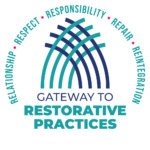
Last week I did an all-day training for an elementary sited called Restorative Practices 101. It is a six-hour overview of restorative practices in schools with an emphasis on practical skills educators can use the next day. A state preschool teacher expressed interest. “I’d like to use restorative practices with my preschoolers.”
“That’s exciting. I’m reading more about restorative practices being implemented in early childhood programs. I’ll send you some ideas next week.”
It had been a while since I’ve done research on this topic, so I decided to see what’s out there before I sent her information. As a former early childhood educator professor, I was shocked at what I discovered.
In 2005, Yale researchers reported that preschoolers are being suspended at three times the rate of those in K-12 grades and that Black children were more likely to be pushed out of preschool.
In 203-2014, 6,743 preschoolers in district provided preschool programs received one or more school suspensions according to the U.S. Department of Education. The statistic didn’t include private or non-school district preschool programs who potentially also had suspensions. I’m anxious to read the book, No Longer Welcome: The Epidemic of Expulsion from Early Childhood Education by Katherine M. Zinsser coming out in August this year.
The Federal government released policy recommendations to reduce expulsions and suspensions in 2014 and updated them in November 2016. They are listed below.
Overview of Recommendations1
- “Establish Fair and Appropriate Policies and Implement them Without Bias
- Invest in a Highly Skilled Workforce
- Access Specialized Supports for Administrators and Educators
- Strengthen Family Partnerships
- Implement Universal Developmental and Behavioral Screening
- Set Goal and Track Data Towards Eliminating Expulsions and Suspensions”
Although I don’t disagree with the recommendations as far as excellence in early childhood, I’m not sure that they will truly address the issue of expulsions and suspensions.
“While there have been some encouraging signs — the rate of suspensions and expulsions fell sharply between the 2015-2016 and the 2017-2018 school years — the same stubborn, stark racial disparities remain. Black boys make up 18 percent of the male preschool enrollment, but 41 percent of male preschool suspensions, and Black girls make up 19 percent of female preschool enrollment, but account for an astounding 53 percent of female suspensions.”2
We’ve seen teacher training on positive discipline strategies, classroom management, social emotional development, and managing specific challenging behaviors. Some researchers suggest that disparities will remain until we focus on implicit bias.
I was able to send the teacher some encouraging news about restorative practices in early childhood but unfortunately no real reassurance on reducing expulsions and suspensions.
What do you think about the guidelines? How are they working for your preschool to reduce expulsions and suspensions?
Sources:
- Spotlighting Progress in Policy and Supports. U.S. Department of Health and Human Services. Updated November 2016. https://www.acf.hhs.gov/sites/default/files/documents/ecd/expulsion_resource_guide_11_4_16_final.pdf
- Strauss, New federal data shows Black preschoolers still disciplined at far higher rates than Whites. November 26, 2020. https://www.washingtonpost.com/education/2020/11/26/new-federal-data-shows-black-preschoolers-still-disciplined-far-higher-rates-than-whites/
- Image: Pumpkins and Preschoolers [Flickr.com]

